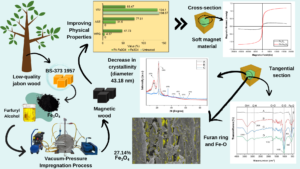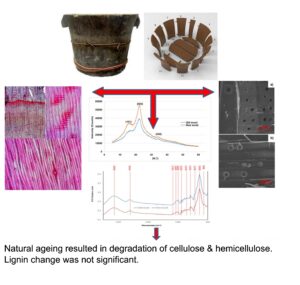Research Articles
Latest articles
- Researchpp 6397-6410Shi, D., Hu, X., Zhang, J., and Du, H. (2022). "Shear stiffness of notched connectors in glue laminated timber-concrete composite beams under fire conditions," BioResources 17(4), 6397-6410.AbstractArticlePDF
Shear connectors ensure effective interaction between wood beams and concrete slabs of composite beams, and their properties noticeably affect the fire resistance of timber-concrete composite beams. To investigate the shear stiffness of notched connectors in glued laminated timber (GLT)-concrete composite beams under fire conditions, 16 shear tests were conducted. The effects of fire duration and notch length on shear properties of the connectors for a given spacing were studied. The fire tests indicated that the reduction of the notch length from 200 mm to 150 mm remarkably affected the failure mode of the shear specimens, changing from compression failure of notched wood to shear failure of notched concrete. The increase in fire duration reduced effective width of the notched wood, negatively affected the shear stiffness and shear capacity of the connectors, and the shear stiffness decreased more rapidly. The notch length did not have a substantial effect on the shear stiffness of connectors. Based on the experimental results, an analytical model to estimate the shear stiffness of notched connectors in GLT-concrete beam under fire conditions was established.
- Researchpp 6411-6444Yue, X., Li, Z., Lam, S., Peng, W., and He, Y. (2022). "Reuse of Cornus officinalis nutlet for bioenergy," BioResources 17(4), 6411-6444.AbstractArticlePDF
As a traditional nourishing Chinese herbal medicine, Cornus officinalis Sieb. et Zucc. has a long history of application. At present, only the flesh of the fruit of Cornus officinalis is used as a medicine, which wastes a large quantity of ingredients in the nutlet. To improve the comprehensive utilization efficiency of the fruit’s nutlet, which could be used when there is a shortage of the plant’s fruit in the market, this study used Fourier transform-infrared spectroscopy (FT-IR), gas chromatography-mass spectrometry (GC-MS), thermogravimetric (TG) analysis, pyrolysis-gas chromatography-mass spectrometry (PY-GC-MS), and nuclear magnetic resonance (NMR) techniques to analyze the Cornus officinalis nutlet. The results showed that the active ingredients of Cornus officinalis nutlet have great medicinal value and could become a substitute for the fruit. After extracting the active ingredients, the residue can be used as a good biomass liquid fuel, providing reference for the future to replace fossil fuels. This study provides the scientific basis for the comprehensive utilization of high-quality resources for Cornus officinalis.
- Researchpp 6445-6463Olarescu, A. M., Lunguleasa, A., and Radulescu, L. (2022). "Using deciduous branch wood and conifer spindle wood to manufacture panels with transverse structure," BioResources 17(4), 6445-6463.AbstractArticlePDF
The increasing demand on the wood market makes it necessary to use all secondary resources, including the wood branches and spindles. The properties of deciduous branches and softwood spindles were evaluated in order to create wood panels, highlighting the transverse texture with high value added. The research analyzed the properties of the wood from deciduous (beech, maple) branches and from conifer (spruce, fir) spindles. The methodology of obtaining panels with transversal structure was also presented. The production of minor wood (branches or spindles) was 254 m3/ha/year in the case of beech (branches) and 109 m3/ha/year in the case of spruce (spindles). The proportion of compression wood for spruce had an average value of 40.6%. A similar value of tension wood for beech was obtained. The modulus of elasticity for pine spindle wood was 71.7% lower than the modulus of elasticity for bending strength in the trunk. The quality index was 36.7% lower in the case of spindles than in the case of pine trunk, and the value of the quality ratio in branch maple wood was 2.61% lower than in trunk wood. Thus, even if it is not the only efficient solution, wood in the minor portions can be used to make high value-added panels such as those that highlight the transverse structure.
- Researchpp 6464-6475Hu, Y., Li, P., Yang, Y., Ling, M., and Li, X. (2022). "Preparation and characterization of biochar from four types of waste biomass under matched conditions," BioResources 17(4), 6464-6475.AbstractArticlePDF
Four contrasting types of waste biomass were subjected to matching treatments to prepare biochar for the potential removal or immobility Cr(VI) in polluted water or soil. Rice straw (RS), rice husk (RH), kraft lignin (KL), and cow dung (CD) were selected. The resulting biochars were characterized by Fourier transform infrared spectroscopy (FTIR), scanning electron microscopy (SEM), and N2 adsorption-desorption isotherms. The physicochemical properties of biochars, such as pH value, ash, yield, and cation exchange capacity (CEC) were also determined. The results showed that the biochars were alkaline, except for the KL biochar (KLBC), which was weakly acidic. Furthermore, the order of CEC was cow dung biochar (CDBC) > rice straw biochar (RSBC) > rice husk biochar (RHBC) > KLBC. FTIR showed that there are abundant oxygen-containing functional groups on the surface of the biochars, with the total amount almost the same, and the structure was dominated by aromatic ring skeleton. The KLBC with micro-nano structure exhibited higher surface area (111 m2/g) than the other BC samples. The Cr(VI) removal followed the order: KLBC > CDBC > RHBC > RSBC.
- Researchpp 6476-6489Wang, H., Xiong, Z., Hu, Y., Liu, Z., and Liang, L. (2022). "Transfer strategy for near infrared analysis model of holocellulose and lignin based on improved slope/bias algorithm," BioResources 17(4), 6476-6489.AbstractArticlePDF
Model transfer techniques in near infrared spectroscopy are important for avoiding duplicate modeling, sharing samples and data resources, and reducing the human and material consumption required for modeling. Use of the slope/bias correction algorithm (S/B) based on screening wavelengths with consistent and stable signals (SWCSS) for model transfer is a new strategy. To enable sharing of near infrared analysis models of pulp holocellulose and lignin content in two different types of spectroscopic instruments, a combined SWCSS-S/B algorithm was proposed. The stable and consistent wavelengths between the spectroscopic instruments screened by the SWCSS method reduced the differences between the instruments, thereby improving the universality and transmission accuracy of the S/B method. The SWCSS-S/B based model transfer method reduced the predicted standard deviation RMSEP of holocellulose and lignin contents of the samples measured on the target spectrometer of the from 5.4686 and 7.6823 to 1.2133 and 1.3494, respectively. This result showed a significant improvement in the transfer effect compared to the SWCSS and S/B correction results alone, and the prediction of holocellulose was better than that of the prediction effect of lignin. The method has fewer wavelength variables involved in model transfer, fast transfer speed, and high prediction accuracy, which provides a new solution for the wide application of NIR analytical models.
- Researchpp 6490-6495Kohútová, M., Peciar, P., Němeček, M., and Fekete, R. (2022). "Selected physical parameters of spruce chips vs. alkali consumptions in the impregnation step of kraft pulping," BioResources 17(4), 6490-6495.AbstractArticlePDF

The uniformity of pulp and the amount of rejects are influenced by many factors, but impregnation can be the most important. The opportunities for improving impregnation of kraft white liquor start in description of the parameters affecting the process. The first parameter is the chip itself (its basic density, moisture, and pH) and the second is the process parameters set by the technological possibilities of the digester. During outside storage, the chips deteriorate via the fungal stains, brittleness, and high acidity. The moisture content also decreases. Understanding the relationships of chip parameters in the impregnation step and amount of rejects requires the assignment of effective alkali consumption. This study shows the effects of selected physical parameters, such as bulk density, moisture, and pH, of spruce chips on alkali consumption during impregnation step of a Super Batch process.
- Researchpp 6496-6510Wahyuningtyas, I., Rahayu, I., Maddu, A., and Prihatini, E. (2022). "Magnetic properties of wood treated with nano-magnetite and furfuryl alcohol impregnation," BioResources 17(4), 6496-6510.AbstractArticlePDF

The impregnation of jabon wood (Anthocephalus cadamba Miq.) with a magnetic compound can increase the quality of the wood. In this study, magnetic woods were made using the ex situ impregnation of jabon woods with nano-magnetite (Fe3O4). The objective of this study was to analyze the characteristics of jabon magnetic wood. Two other impregnation solutions were also used in this study: (1) water (untreated) and (2) furfuryl alcohol plus nano-magnetite. The physical properties of magnetic jabon wood were improved compared with untreated wood, as shown by the results of the characterization tests. Scanning electron microscopy with energy-dispersive X-ray spectroscopy showed nano-magnetite in the micropores of magnetic jabon wood. The results of the Fourier-transform infrared spectroscopy showed chemical bonding between the wood polymer and the furan ring and Fe-O functional groups. The X-ray diffraction results showed a decrease in the degree of crystallinity as the concentration of nano-magnetite increased. The magnetic properties were tested via vibrating-sample magnetometry and the FA-Fe3O4-treated wood showed the highest magnetization.
- Researchpp 6511-6520Tu, X. W., Liu, X. Y., and Varodi, A. M. (2022). "Characterization and identification of wooden rice bucket made in 1860s," BioResources 17(4), 6511-6520.AbstractArticlePDF

This study presents the results of a comprehensive investigation of a wooden rice bucket made in the 1860s. Macroscopy aspects and microscopic structure were conducted to identify the wood species. X-ray diffraction (XRD), Fourier-transform infrared spectroscopy (FTIR), and scanning electron microscopy (SEM) were also adopted to investigate the degradation degree of the rice bucket compared with a new wood sample from the same species. The results of the microscopic identification concluded that the rice bucket was made of Chinese fir (Cunninghamia lanceolata). The XRD pattern indicated that the crystallinity degree of cellulose in the wooden rice bucket decreased to 33.2% from 38.8% (new wood). The FTIR spectra revealed that natural ageing resulted in the degradation of cellulose and hemicellulose, and the change of lignin was not obvious.
- Researchpp 6521-6531Liu, X., Lei, C., and Fang, Y. (2022). "Fully bio-based chitosan/sodium alginate coating for flame retardant Xuan paper," BioResources 17(4), 6521-6531.AbstractArticlePDF
The development of bio-based flame retardants has received increasing attention. In this study, fully bio-based chitosan/sodium alginate (CS/SA) coating was applied by layer-by-layer (LbL) assembly on Xuan paper to improve its flame retardancy. The LOI value of Xuan paper reached 33.3% after 20 BLs CS/SA coating. Its char length was reduced to 8.8 cm with no after-flame and after-glow. These results showed that the flame retardancy of Xuan paper was greatly improved by LbL assembly CS/SA coating. Thermogravimetry results revealed that CS/SA coating on Xuan paper slowed down the thermal degradation process and promoted the char formation both under nitrogen and air atmosphere. The stable char layer formation by CS/SA coating covered on the Xuan paper inhibited the heat transfer and diffusion of combustible gases, showing obvious condensed phase flame retardant action. Scanning electron microscopy confirmed that CS/SA coating on paper fiber promoted the char formation to form the stable covering layer. Furthermore, the CS/SA coating formed non-flammable gases to enhance the flame retardancy of Xuan paper, showing a certain gas phase flame retardant action. This research provides a new approach for fire-resistant Xuan paper by using fully bio-based compounds.
- Researchpp 6532-6541Kim, B., Park, K., Park, H., and Park, S. (2022). "Quantification of microbial growth pattern on growth medium using image processing program and evaluation of antifungal activities of wood vinegar," BioResources 17(4), 6532-6541.AbstractArticlePDF

Digitized growth pattern images of wood-rotting fungi Fomitopsis palustris (FOM) and Trametes versicolor (TRA) were used with a video processing program with a new formula to calculate the numerical results of microbial inhibition by an active substance (wood vinegar). First, images of daily growth pattern were collected to generate calibration curves for each fungus. FOM stopped growing in 7 days, whereas TRA stopped growing in 11 days. The calibration curves FOM and TRA showed R2 = 0.9899 and 0.8880, respectively. The new methods allow numerical comparison by adding different concentrations of active components (wood vinegar) to assess the inhibition effect of microbial growth. Using the formula allowed the results of inhibition effect to be collected as numerical data. Through the image data, it was possible to present daily inhibitory efficacy data in detail, numerically. Based on these results, microbial growth pattern could be evaluated.
